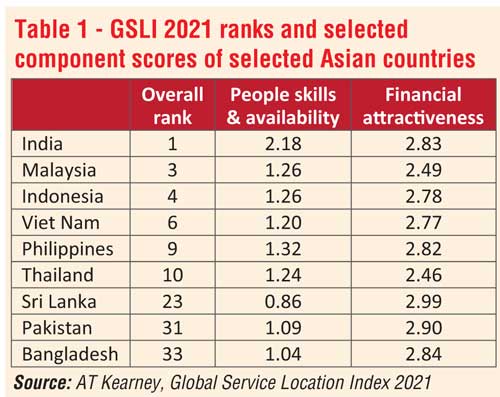Monday Dec 15, 2025
Monday Dec 15, 2025
Tuesday, 20 July 2021 00:33 - - {{hitsCtrl.values.hits}}

Software and business process outsourcing are not top of mind these days. Food security and end of Ceylon Tea are. But we should focus on software, knowledge process outsourcing, and associated activities. Banning fertiliser and vehicle imports are temporary patches to the core problem that is besetting Sri Lanka: we do not export enough; our exports are not diversified enough and of high added value
 It was 11 years ago that I wrote a column entitled ‘Sri Lanka’s ITES: The problem is people’ and pointed out that the sector suffered from problems of quantity and quality affecting its critical input. Preparing for a discussion on what we should ask from our tertiary education institutions, I revisited the sources used in that article. It was not a happy picture. Not only had we not made progress, but we are also in danger of falling back.
It was 11 years ago that I wrote a column entitled ‘Sri Lanka’s ITES: The problem is people’ and pointed out that the sector suffered from problems of quantity and quality affecting its critical input. Preparing for a discussion on what we should ask from our tertiary education institutions, I revisited the sources used in that article. It was not a happy picture. Not only had we not made progress, but we are also in danger of falling back.
Software and business process outsourcing are not top of mind these days. Food security and end of Ceylon Tea are. But we should focus on software, knowledge process outsourcing, and associated activities. Banning fertiliser and vehicle imports are temporary patches to the core problem that is besetting Sri Lanka: we do not export enough; our exports are not diversified enough and of high added value.
Exports that rely less on imports
The Government’s misguided import restrictions are likely to harm many of our exports. Restrictions or permit-based imports of critical inputs such as fertiliser, weedicides, and insecticides are likely to kill or maim the fast-growing fruit, vegetable and foliage export sectors. Enough has been said about tea.
The textile and garment sector which pulled in $ 4.4 billion even in the plague year of 2020 and is the largest contributor to exports (44%), is also among the largest importers. In 2020, this sector was responsible for 14.5% of all imports. Add friction to the import process, exports will suffer.
As the mismanagement of the economy is sought to be remedied by even more inept interventions by officials, we will be on a fast track back to the corrupt license raj that was dismantled in the early 1990s.
The software and associated industries (described by various acronyms, but let’s settle for IT-BPM) require very few imported inputs. It is true that they cannot function without computers and the ability to use cloud service for certain SaaS applications, etc., but they are less vulnerable to government stupidity than many conventional manufacturing or agricultural industries.
Given the difficulty of reversing the current drift toward disaster, it may be wise to promote exports that are relatively insulated from the depredations of the license raj. The IT-BPM sector which has been identified as a priority sector by the National Export Strategy is an obvious candidate. Even that epitome of self-reliance, North Korea, exports coal to China so it can import fuel for the motorcades of the leadership.
 The problem is people
The problem is people
The biggest and most critical input for the IT-BPM sector is people. The Global Services Location Index (GSLI) published annually by AT Kearney is a key source of information used by those entering into contracts for services. As Sri Lanka was rising in the rankings, the ICT Agency relied heavily on the Index to talk up Sri Lanka’s attractiveness as a place to do business in. Therefore, it is reasonable to examine how Sri Lanka would be perceived by a user of AT Kearney’s index.
The good news is that GSLI 2021 includes Sri Lanka in the Top 25. The bad news comes layered. The old bad news and the new. Let’s start with the old bad news identified in 2011.
The GSLI ranks 60 countries. Theoretically, service supply can take place anywhere. But let us compare Sri Lanka only to its South and South East Asian peers.
On the key resource of people skills and availability, Sri Lanka is last among its peers, behind even Bangladesh and Pakistan. When I last wrote on this subject, Bangladesh was not even included in the GSLI.
The problematic component in the index includes both quality and quantity. For those who prefer not to look hard truth in the eye, this leaves a possible escape path. Sri Lanka’s work force has the skills but being a small country, there just aren’t enough people to hire.
It cannot be denied that there is a quantity problem. I have heard enough cases of investment going elsewhere, because Sri Lankan operations have trouble scaling up. Perhaps the pensionable jobs in Government are a part of the problem. Malaysia does not have that big a population, but it does way better on people skills and availability.
But the gap suggests that quality is also a major contributor to our poor performance (more will be said on this below).
Why is Sri Lanka still in the Top 25?
Sri Lanka is still an attractive location for supply of services because it’s cheap. Among its South and South East Asian peers, it has the highest score for financial attractiveness. Malaysia and Thailand are ranked third and 10th, despite their financial unattractiveness. Sri Lanka is hanging in almost solely because of its financial attractiveness.
When we were working to attract BPO business to Sri Lanka in 2002-’04, a major concern was that Colombo salaries were unlikely to be competitive with the established locations in Andhra Pradesh, Karnataka and Tamil Nadu. Appears we worried needlessly. In 2009, we were equal to India in financial attractiveness; Philippines was cheaper. While everyone else was raising their prices (and compensating their staff better, one hopes), Sri Lankan companies kept their prices down. As with tourism, Sri Lankan IT-BPM competes on price, not value.
What does the future hold?
International organisations and companies that produce composite indexes for all sorts of things ranging for innovation to ease of doing business, keep tweaking their indicators and weights. This is especially important in rapidly changing fields such as information and communication technology business.
AT Kearney had introduced a new component worth 10% called digital resonance to reflect strengths in digital skills of the labour force, digital outputs, the amount of corporate activity, legal protections of intellectual property, and other elements of business activity. It is their considered judgment that these elements are becoming more important than the old considerations of low costs. They are proposing to increase the weight given to digital resonance from 10% to 60.
When this is done, the rankings change dramatically. The United States and the United Kingdom displace India and China from first and second places. China drops down only two places to be fourth. India, on the other hand, drops 10 places. Singapore, which was not even in the Top 25, moves up 35 places to occupy third place after the US and UK. Malaysia and Indonesia suffer grievous declines but hang on in the Top 25. And Sri Lanka, which owed its place in the Top 25 to cheapness, drops down into oblivion.
Collectively, we failed to take the necessary remedial actions to the people problems identified a decade ago. Talk about our high literacy and the elegance of the software written by the graduates of the top programs will not take us to $ 5 billion in IT-BPM exports. Unless hard truths are faced and radical remedies are adopted, this too could be another bus we missed.